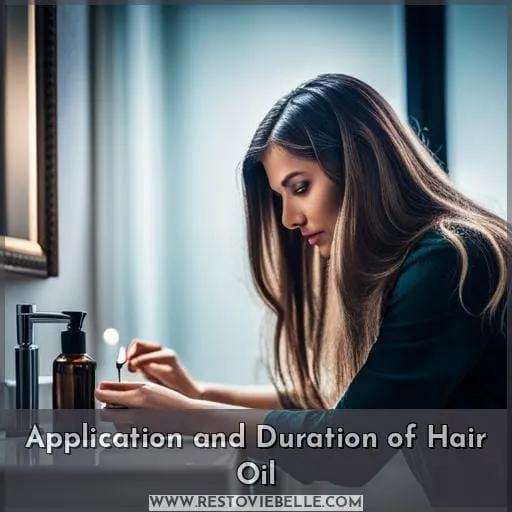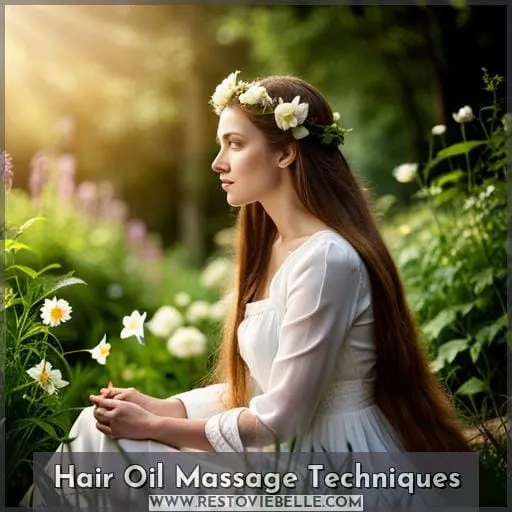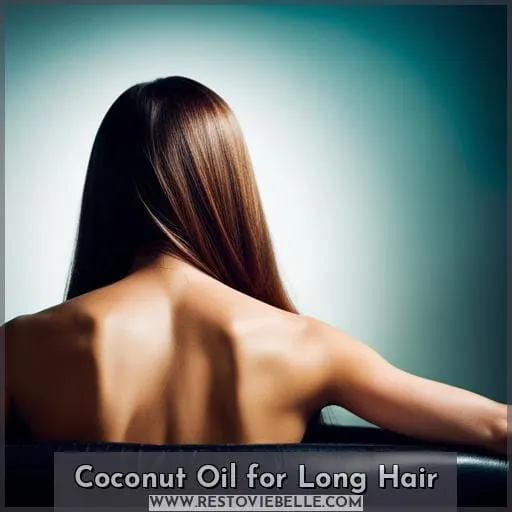This site is supported by our readers. We may earn a commission, at no cost to you, if you purchase through links.

This article provides guidelines on factors that affect oil quantity for long hair, choosing the right type of oil, application techniques, and more – so you’re armed with everything you need to keep those luscious tresses healthy!
From individual texture and length to types like curly or straight – there are a lot of things that determine how much oil works best for each person’s unique mane. Hair oils from natural sources such as coconut, argan, or jojoba provide deep conditioning benefits like protection against damage caused by heat styling tools as well as dandruff prevention.
The key is finding out which one will work best for your particular case in order to reap all these wonderful rewards without over-oiling (or under-oiling) causing dryness or buildup respectively.
Table Of Contents
- Key Takeaways
- Factors Affecting Oil Quantity for Long Hair
- Guidelines for Determining the Right Amount of Oil
- Benefits and Frequency of Oiling for Long Hair
- Choosing the Right Oil for Long Hair
- Application and Duration of Hair Oil
- Avoiding Excess Oil and Wrong Oil Choice
- Hair Oil Massage Techniques
- Coconut Oil for Long Hair
- Frequently Asked Questions (FAQs)
- Conclusion
Key Takeaways
- Determining the right oil quantity is important to prevent greasiness or dryness.
- The optimal amount of oil for long hair is around 0.5 – 1 teaspoon per application.
- Natural oils like coconut, argan, or jojoba are recommended for deep conditioning benefits.
- Applying oil twice weekly, adjusting based on hair type, is suggested for maintaining healthy long hair.
Factors Affecting Oil Quantity for Long Hair
Discover the right amount of oil for your long locks – it’s key to keeping them healthy and looking their best!
Many factors influence how much you should use, such as hair texture, type, and length. Over-oiling can lead to greasy strands, while under-oiling causes breakage and split ends.
For long locks, a good rule of thumb is approximately 0.5 – 1 teaspoon of quality natural oils like coconut or jojoba per application. Oils nourish the scalp, add shine, and stimulate growth. Apply twice weekly depending on hair type, with heavier varieties used less frequently than lighter ones like coconut oil, which can be applied more often if desired.
Massaging gently in circular motions helps absorption, while warm towels enhance penetration further still! Avoiding excessive applications reduces buildup but also prevents stripping away necessary natural oils that keep your mane luxurious, so take care when choosing an appropriate amount for your individual needs.
Guidelines for Determining the Right Amount of Oil
Finding the right amount of oil for long hair is a tricky process that requires taking into account factors like texture, length, and type. It’s important to avoid over-oiling or under-oiling, as this can lead to greasy hair or split ends, respectively.
Hair Texture, Length, and Type
You can determine the right amount of oil for your long hair by considering its texture, length, and type. Matching oil types to your hair is key – use heavier oils like castor or lighter ones such as coconut more regularly.
Oiling with a wide-tooth comb boosts scalp circulation, while applying warm oil aids penetration. Coconut’s unique properties give extra protection; massage it in for best results. Benefits include shine and growth stimulation – keep track of how much you need depending on hair length! Avoid overdoing it; excessive amounts lead to greasy buildup or dryness instead of nourishment.
Avoiding Over-Oiling and Under-Oiling
Avoiding over-oiling and under-oiling your long hair is key to maintaining its health – but how do you know what’s right for you? Here are a few tips:
- Understand different oiling strategies based on your hair type.
- Consider using lighter oils like coconut or heavier ones like castor oil, in moderation.
- Use hot towels to enhance absorption of the oils applied.
- Remember that too much can lead to greasiness and split ends, or lack thereof may cause breakage.
- Follow haircare tips such as proper application frequency for best results.
Oils provide nourishment, protection against damage, and shine – all essential elements of healthy tresses! Take advantage of these benefits without risking any harm by following simple guidelines.
Benefits and Frequency of Oiling for Long Hair
You have come to the right place for information about oiling your long hair. Oiling is essential for nourishing and adding shine to your strands, stimulating growth, preventing dandruff, and damage.
Nourishment and Shine
By regularly oiling your long hair, you can not only nourish and protect it but also add great shine – so how often should you be doing this?
Overnight oiling offers maximum hydration for the scalp. Choose natural oils like coconut, argan, or jojoba for moisturizing protection from split ends and protein loss.
For dandruff prevention, apply a few drops of warm oil to the scalp once every week.
To boost shine without over-oiling, use 0.5 to 1 teaspoon per application on damp hair after showering at least twice a week as required by your hair type and texture.
Follow proper techniques when massaging to maximize absorption of these beneficial oils into your tresses! With careful selection of quality ingredients combined with effective application methods, you will achieve amazing results in terms of both nourishment and shine!
Hair Growth Stimulation
Regularly oiling your hair stimulates growth and helps you maintain a healthy mane.
- Nourishment
- Shine
- Protection from damage and breakage
- Stimulation of blood circulation for hair growth.
Natural oils like coconut, argan, or jojoba are best used in small amounts to avoid overuse that can lead to greasy strands. Scalp massage with circular motions using warm oil aids absorption while promoting root to tip nourishment.
The unique chemical composition of coconut oil protects the hair structure by preventing protein loss and keeping the cuticle layer intact.
Prevention of Dandruff and Damage
Nourish your hair and protect it from dandruff with regular oiling – you’ll thank yourself later! Oiling is essential to prevent split ends, dryness issues, and seborrheic dermatitis.
Warm towels enhance absorption of the oil while massaging in circular motions helps nourish the scalp and hair follicles. Leave-in time depends on the choice of oil; traditional haircare recommends 1-2 hours depending on the type and length of hair.
Different types need different care; use lighter oils more frequently than heavier ones and consider using an all-natural scrub to boost benefits further! End with thorough shampooing for maximum nourishment that will leave your locks feeling revitalized and healthy.
Choosing the Right Oil for Long Hair
Choosing the right oil for long hair can be tricky. Natural oils such as coconut, argan, and jojoba are recommended to ensure proper nourishment without causing greasiness or dryness. It is important to match the oil type with your specific hair texture and length in order to get optimal results.
Natural Oils (Coconut, Argan, Jojoba)
Choose natural oils such as coconut, argan, or jojoba to replenish and add luster to your long hair. Each oil type has different characteristics that make it suitable for particular hair types. Warm oil can help with penetration while a scalp massage boosts circulation and growth.
Coconut is great for preventing protein loss and protecting the cuticle layer; use it as a detangler or mask too! Argan helps moisturize while Jojoba reduces dandruff without stripping natural oils from your strands.
Oil frequency depends on one’s hair type; oily should avoid excessive use whereas dry needs more frequent care.
Matching Oil to Hair Type
Matching the right oil to your hair type is essential for achieving healthy, nourished locks. Choose a heavier oil like castor for occasional use or lighter oils like coconut more frequently. Consider factors such as: 1) Hair texture and length; 2) Oil types formulated specifically for your hair type; 3) Benefits of natural oils (prevents protein loss, lice & dandruff); 4) How to apply (section off and massage gently).
Ensure proper application by using a toner/scrub in between washes and avoid over-oiling—this leads to greasiness or split ends! Choosing the right oil helps tangle-free, shinier locks with fewer breakages.
Application and Duration of Hair Oil
Applying hair oil correctly and for the right duration can bring numerous benefits. It is important to understand the proper application techniques, as well as why applying to damp hair increases effectiveness.
Generally, treatments should last 1-2 hours. To get the most out of your treatment and nourish your locks with natural oils, follow these guidelines carefully.
Proper Application Techniques
When it comes to oiling long hair, make sure you use the right technique for a successful result. Massage in small circles with your fingertips using warm oil. This will increase circulation and nourish the scalp and strands.
Coconut oil is especially effective because of its unique chemical structure, which helps protect hair cuticles from damage.
For even distribution, start at the roots before lathering up the damp lengths all the way down to the tips. Then, rinse thoroughly after shampooing to have a clean scalp with no excess buildup or greasiness.
Traditional practice recommends daily massages, but pay attention to your own individual needs. Too much oiling could lead to dryness, while not enough can cause breakage and split ends.
Benefits of Applying to Damp Hair
Applying oil to damp hair can help it better penetrate the strands, delivering nourishing benefits and protecting your locks from damage. Warm oil aids absorption, while scalp massage with gentle circular motions stimulates blood flow for hair growth.
Traditional practices passed down through generations combined with daily grooming routines that consider the structure of the hair are best practices for a successful treatment.
Hot towels enhance absorption as well and make it easier to obtain desired results such as healthy shine or nourishment following your chosen method of application.
Duration of Treatment
The duration of treatment varies depending on your hair type and the oil you use, so experiment to find what works best for you. Scalp massages with warm oils can enhance absorption and help maintain healthy hair structure.
Dry hair will require more frequent oiling than oily or normal types; however, overnight treatments should be avoided as they can result in buildup and greasiness.
Different oils have unique benefits – coconut is great for preventing protein loss while jojoba helps reduce dandruff – so consider trying different options until you find one that suits your needs!
Frequency depends on desired results; most people benefit from twice-weekly applications but some may need more or less depending on their overall goals.
Avoiding Excess Oil and Wrong Oil Choice
Excess oil and incorrect oil selection can have detrimental effects on your long hair. Applying too much oil can lead to greasiness and buildup, while using the wrong type of oil can strip away natural oils from your strands, leaving them dry.
Greasiness and Buildup
Overusing oil can cause greasiness and buildup, so it’s important to use only the recommended amount for your hair type. A whopping 90% of women over-oil their hair! Oil selection is key. Heavier oils should be used occasionally, while lighter oils are better for frequent treatments.
Avoiding oily residue and buildup means ensuring proper application methods as well as selecting the right oil tailored to your individual needs. Oiling too much leads to scalp health problems like dandruff or clogged pores and damages strands with split ends or breakage.
Stripping Natural Oils
Wrongly choosing oil can lead to stripped natural oils, leaving your hair dry. Poor quality or the wrong type of oil can cause split ends and weakened strands, while reducing dandruff prevention. Oil application should be done in moderation and with the right product for best results.
Too much oil may result in red patches on the scalp or a greasy texture. Benefits from using oil include nourishment, shine stimulation, and protection. However, over-oiling might have disadvantages such as clogged pores leading to breakage.
Quality matters when it comes to a hair care routine, so make sure you understand all the benefits and risks associated with different types of oils before applying them directly onto your locks.
Hair Oil Massage Techniques
To maximize hair health, scalp massage can be used to stimulate circulation and growth. To ensure the best results, gentle circular motions should be employed when massaging the scalp, and warm oil or hot towels may help enhance absorption into the strands.
Scalp Massage for Circulation and Growth
Gently massaging your scalp with oil can help stimulate circulation and encourage hair growth. It’s essential to seek advice from a dermatologist to select the right natural ingredients for your specific hair type, concerns, and routine.
Consider factors such as scalp health, oil absorption, natural ingredients, hair type, concerns, routine, and oil quantity. By oiling your scalp, you can nourish it and promote healthy hair growth without over- or under-oiling.
To ensure maximum absorption of nutrients from the oils, use circular motions on a clean or damp scalp.
Gentle and Circular Motions
Circularly massage your scalp with oil to boost circulation and hair growth. Use a conditioner, detangler, or mask treatment for added nourishment. Coconut oil helps prevent protein loss and protect the cuticle layer. Add a hair toner or scrub routine to complete the process of choosing the right oil – it’s essential for healthy hair.
Enhancing Absorption With Warm Oil and Hot Towels
Enhance oil absorption with warm oil and hot towels for best results, just as a sauna helps your body absorb moisture more effectively. Oiling correctly is essential to avoid greasy hair or breakage due to under-oiling.
A scalp massage using gentle, circular motions along with an appropriate amount of natural oils like coconut, argan, or jojoba can help nourish hair while adding shine and stimulating growth.
Hot towels help increase absorption of the oil into the scalp but should not be too hot – use caution! Additionally, consider factors such as hair texture type when determining how much oil to apply; lighter oils may need more frequent application than heavier ones.
With these techniques in mind, you’ll reap all the benefits that come from correct hair-oiling without any drawbacks!
Coconut Oil for Long Hair
Caring for long hair requires special attention, and using the right oil can make a big difference. Coconut oil provides both protection and moisturization, with different uses and amounts depending on your individual hair type.
It’s an excellent choice to help keep strands healthy, manageable, shiny, and strong.
Benefits for Hair Protection and Moisturization
Cocoon your hair in the protective and moisturizing properties of coconut oil to keep it looking healthy and shiny. Coconut oil is a natural, budget-friendly solution for preventing dandruff, reducing split ends, and stimulating hair growth.
Use specific oils to target certain issues. Solid oils like castor can address specific problems, whereas lighter ones like jojoba are perfect as an everyday option. For added nourishment, massage the scalp with circular motions using warm coconut oil before washing off any excess residue from strands.
Various Uses and Amounts for Different Hair Types
It’s important to choose the right oil for your hair type and length, as well as apply it correctly. Oily scalps should use lighter oils like coconut; heavier oils like castor are best used occasionally.
A hair toner or scrub can complement your routine based on advice from a professional stylist.
Steam treatments are great for penetrating the scalp when applying oil, while split ends may benefit from heavy moisturizing products such as jojoba oil if needed.
How many ounces of oil do I need for long hair? Depending on texture and thickness, usually 0.
Frequently Asked Questions (FAQs)
What is the best way to apply oil to long hair?
Apply oil to your long hair by using 5-1 teaspoon of natural oils, such as coconut, argan, or jojoba. Massage in a gentle circular motion for better absorption and protection from damage. Use warm oil or towels to enhance penetration and leave it on for 1-2 hours before washing off with shampoo.
How often should long hair be oiled?
Oiling long hair twice a week provides nourishment, shine, and protection. Choose natural oils like coconut, argan, or jojoba for best results; the quantity depends on texture and length.
What is the difference between heavy and light oils?
Heavy oils, such as castor oil, are used occasionally and provide more powerful nourishment. Lighter oils like coconut oil can be used more frequently and offer thinner formulas that penetrate hair strands easily.
Are there any effects of oiling long hair too often?
Oiling long hair too often can cause greasy, heavy buildup. It can also strip natural oils from your strands, leaving them dry and prone to breakage. Use quality oils like coconut or argan in moderation for nourishment and protection.
Are there any additional benefits of using coconut oil for long hair?
Yes! Coconut oil has many additional benefits for long hair. It helps prevent protein loss, protects the cuticle layer, moisturizes, and prevents damage from grooming. Plus, it can reduce lice and dandruff too! Try using it as a conditioner or detangler to reap its rewards.
Conclusion
Beautiful, brilliant, and bountiful locks are a dream come true for many. To help you achieve and maintain long, healthy hair, it’s important to know how to oil it properly. Depending on your hair type, texture, and length, the right amount of oil can vary.
Generally, 0.5 to 1 teaspoon of oil is enough for long hair, and natural oils such as coconut, argan, and jojoba are recommended. Oiling your hair regularly helps nourish and protect it, while scalp massages promote circulation and growth.
Coconut oil is especially beneficial for hair and can be used as a conditioner, detangler, mask, or scalp treatment.
Just remember to avoid excess oil, as it can lead to greasiness and buildup. With the right knowledge and practice, you can achieve the long, healthy hair of your dreams.














